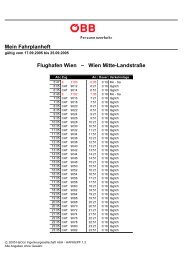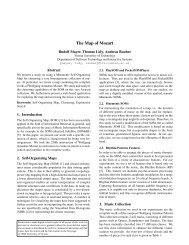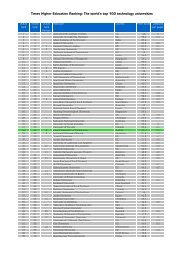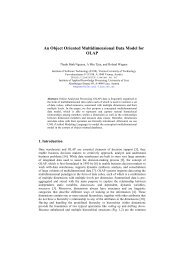Using Psycho-Acoustic Models and Self-Organizing Maps to Create ...
Using Psycho-Acoustic Models and Self-Organizing Maps to Create ...
Using Psycho-Acoustic Models and Self-Organizing Maps to Create ...
Create successful ePaper yourself
Turn your PDF publications into a flip-book with our unique Google optimized e-Paper software.
“<br />
À<br />
‘<br />
<strong>Using</strong> <strong>Psycho</strong>-<strong>Acoustic</strong> <strong>Models</strong> <strong>and</strong> ¢¡¤£¦¥ <strong>to</strong> create a Hierarchical Structuring of Music<br />
bfmc−uprocking<br />
themangotree<br />
bfmc−instereo<br />
bfmc−rocking<br />
bfmc−skylimit<br />
bongobong<br />
cocojambo<br />
limp−n2gether<br />
macarena<br />
rockdj<br />
conga<br />
mindfiels<br />
lovsisintheair<br />
eifel65−blue<br />
fromnewyork<strong>to</strong>la<br />
gowest<br />
manicmonday<br />
radio<br />
supertrouper<br />
sl−summertime<br />
rhcp−californication<br />
rhcp−world<br />
sl−whatigot<br />
bfmc−freestyler<br />
sexbomb<br />
<strong>to</strong>rn<br />
ga−doedel<br />
ga−iwantit<br />
ga−japan<br />
nma−bigblue<br />
limp−nobody<br />
pr−broken<br />
ga−nospeech<br />
limp−pollution<br />
korn−freak<br />
pr−deadcell<br />
pr−revenge<br />
dancingqueen<br />
firsttime<br />
foreveryoung<br />
frozen<br />
californiadream<br />
risingsun<br />
unbreakmyheart<br />
missathing<br />
friend<br />
yesterday−b<br />
eternalflame<br />
feeling<br />
drummerboy<br />
father<strong>and</strong>son<br />
ironic<br />
future<br />
lovemetender<br />
therose<br />
beethoven<br />
fuguedminor<br />
vm−bach<br />
vm−brahms<br />
bigworld<br />
addict<br />
ga−lie<br />
angels<br />
newyork<br />
sml−adia<br />
americanpie<br />
lovedwoman<br />
revolution<br />
memory<br />
rainbow<br />
threetimesalady<br />
br<strong>and</strong>en<br />
air<br />
avemaria<br />
elise<br />
kidscene<br />
mond<br />
†ˆ‡y‰.ŠF‹Œkj<br />
˜ ž ’vŠ ‡yq˜=¡y¡yŒ"<br />
mlu¾¦Ž<br />
‡y˜.š<br />
the same general trends of organization, thus alleviating the common<br />
problem of cluster separation in hierarchical organizations.<br />
Some interesting insights in<strong>to</strong> the music collection which the m0pxe<br />
map, organizing the collection in<strong>to</strong> 9 major styles of music. The<br />
bot<strong>to</strong>m right represents mainly classical music, while the upper left<br />
mainly represents a mixture of Hip Hop, Electro, <strong>and</strong> House by<br />
d| ¬ r [ g"zb¤¨ Ckr ¬ ¯<br />
. The upper-right, center-right, <strong>and</strong> uppercenter<br />
represent mainly disco music such ˆuÆ¢ as ˆRkk$_ by<br />
¬ x \ iL° ¯<br />
, dJ© [ _ by ] n|_$©poPqC_: n|_$©roPqe7k© [ _ ¯<br />
, or X \ _:g<br />
Lº©A©<br />
bfRiRgsg=¦ r \ 9_:g ¯<br />
by . Please note, that the organization does not<br />
follow clean “conceptual” genre styles, splitting by definition, e.g.<br />
wspx:w <strong>and</strong> p… [ $_ , but rather reflects the overall sound similarity.<br />
p{<br />
Seven of these 9 first-level categories are further refined on the second<br />
level. For example, the bot<strong>to</strong>m right unit representing classical<br />
music is divided in<strong>to</strong> 4 further sub-categories. Of these 4 categories<br />
the lower-right represents slow <strong>and</strong> peaceful music, mainly<br />
piano pieces such XZY as<br />
© A$_ËC_$© A$_ ¯<br />
<strong>and</strong> bvg'i:h¢_:Ags$g=~7_<br />
[Q\Z]<br />
¬ g=i ¯<br />
by d{__:~yhs´_:g , or X \ _ ¬ i_º¹ Y g'i_ \q[ g=i¦bc_:g¢:h¢_:g by<br />
<br />
[Q¬ gsg i$_:g=_ ¯<br />
. The upper-right represents, for example,<br />
`'h<br />
pieces sg=_::Ëbf_ by (vm), which, in this case, are more dynamic<br />
interpretations of classical pieces played on the violin. In the<br />
upper-left orchestral music is located such as the as the end credits<br />
of the dJR…~*¢~yhs_X [ ~ [Q\ _<br />
KtKtK<br />
r [ ~ [Q\ _ ¯<br />
film <strong>and</strong> the slow love<br />
«<br />
song<br />
by d{_:~~7_JbËis©t_ \ 7~yh¢_ \ $_ ¯<br />
, exhibiting a more intensive<br />
h¢_ˆ$_<br />
sound sensation, whereas the lower right corner unit represents the<br />
\ g=iR_:g=k [Q\ ov¨0g'_ \ ~ by d|Rhf»k \ g'i_:g ¯<br />
.<br />
d<br />
Generally speaking, we find the softer, more peaceful songs on this<br />
second level map located in the lower half of the map, whereas the<br />
more dynamic, intensive songs are located in the upper half. This<br />
corresponds <strong>to</strong> the general organization of the map in the first layer,<br />
where the unit representing Classic music is located in the lower right<br />
corner, having more aggressive music as its upper <strong>and</strong> left neighbors.<br />
This allows us, even on lower-level maps, <strong>to</strong> move across map<br />
boundaries <strong>to</strong> find similar music on the neighboring map following<br />
reveals are, for example, that the song X \ __:~}©t_ \<br />
by dJ ¬ e<br />
`5aNb<br />
[ gQjb®¨ (center-left) is quite different then the other songs by<br />
r<br />
the same X \ __:~}©t_ \<br />
group. was the groups biggest hit so far <strong>and</strong>,<br />
unlike their other songs, has been appreciate by a broader audience.<br />
Generally, the pieces of one group have similar sound characteristics<br />
<strong>and</strong> thus are located within the same categories. This applies, for<br />
example, <strong>to</strong> the songs m [ g'vu·ws_:¤oR ¯<br />
of ‚:w"…RhjSw \7¯<br />
<strong>and</strong> ,<br />
which are located in the center of the 9 first-level categories <strong>to</strong>gether<br />
with other aggressive rock songs. However, another exception is<br />
u¹O*_ by m [ g' uØws_:uoRe*© *_ ¯<br />
, located in the lowerleft.<br />
Listening <strong>to</strong> this piece reveals, that it is much slower than the<br />
¹OA´Ago¦Aģ<br />
other pieces of the group, <strong>and</strong> that this song matches very well <strong>to</strong>,<br />
for û iRi$~ example, xw ¨Fhs:_ by .<br />
5.2 A GHSOM of 359 pieces of music<br />
In this section we present results from using the `5aNbc_d system<br />
<strong>to</strong> structure a larger collection of 359 pieces of music. Due <strong>to</strong> space<br />
constraints we cannot display or discuss the full hierarchy in detail.<br />
We will thus pick a few examples <strong>to</strong> show the characteristics of the<br />
resulting hierarchy, inviting the reader <strong>to</strong> explore <strong>and</strong> evaluate the<br />
complete hierarchy via the project homepage.<br />
The mNp{`Fa0b<br />
resulting has grown <strong>to</strong> a size §ºîzy of units on the<br />
<strong>to</strong>p layer map. All 8 <strong>to</strong>p-layer units were exp<strong>and</strong>ed on<strong>to</strong> a second<br />
layer in the hierarchy, from which 25 units out of 64 units <strong>to</strong>tal<br />
on this layer were further exp<strong>and</strong>ed in<strong>to</strong> a third layer. None of<br />
the branches required expansion in<strong>to</strong> a fourth layer at the required<br />
level-of-detail setting. An integrated view of the two <strong>to</strong>p-layers of<br />
the map is depicted in Figure 8. We will now take a closer look at







![Informationsvisualisierung [WS0708 | 01 ]](https://img.yumpu.com/22537403/1/190x143/informationsvisualisierung-ws0708-01-.jpg?quality=85)








